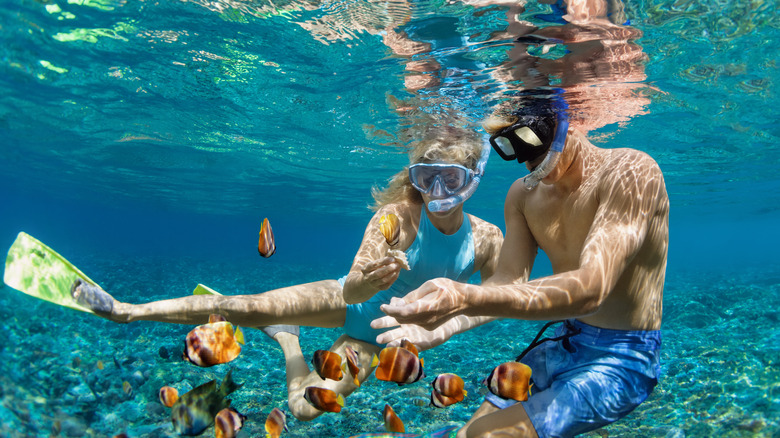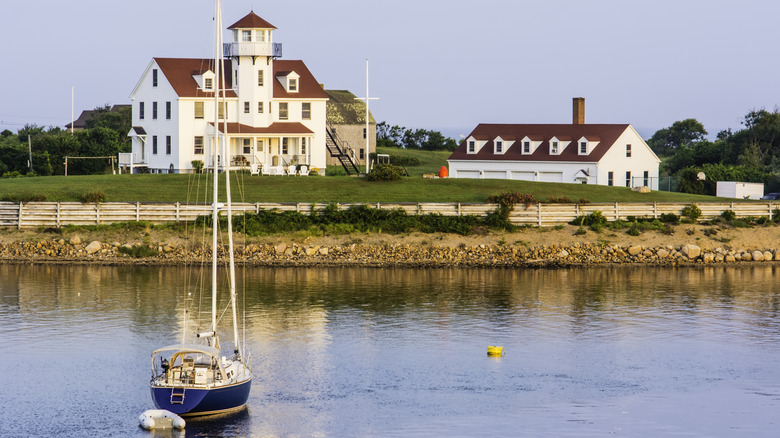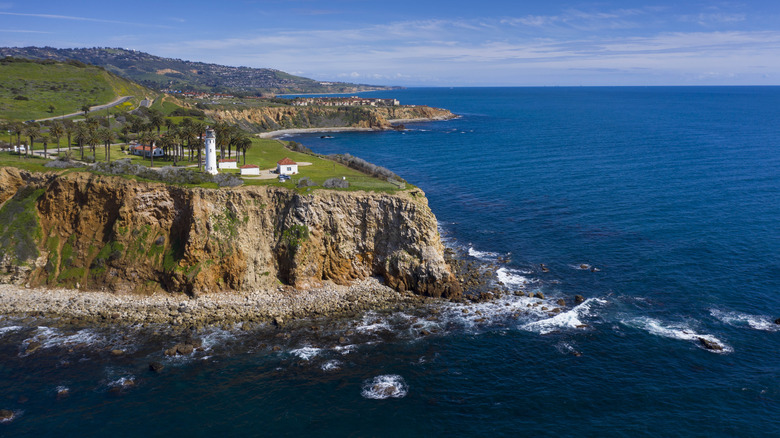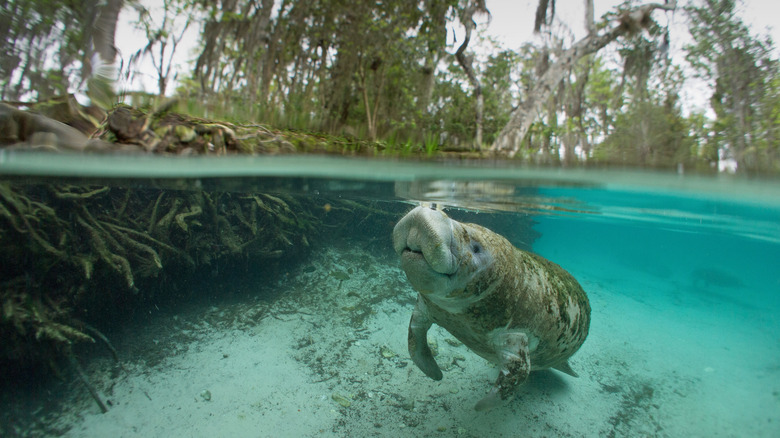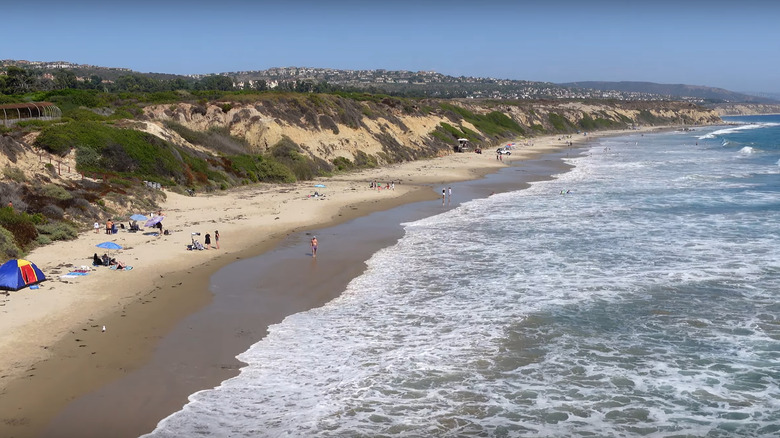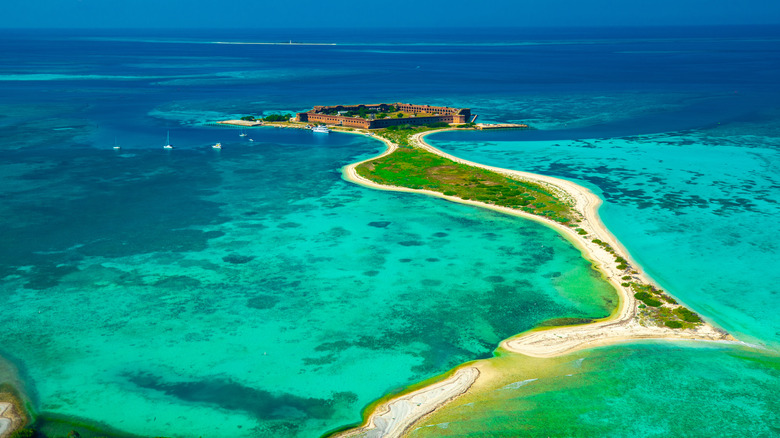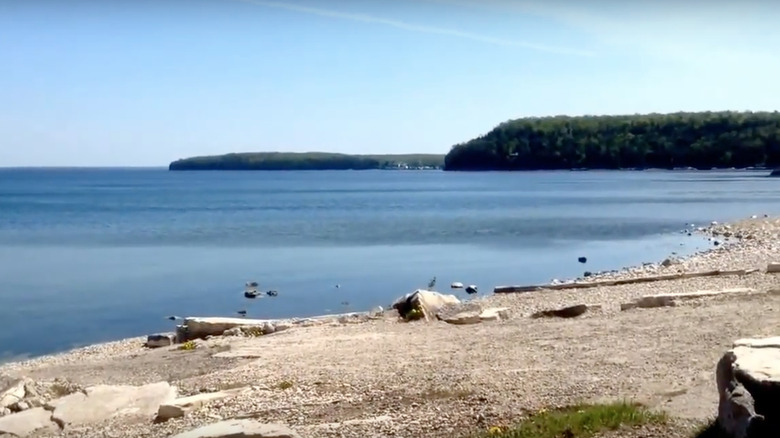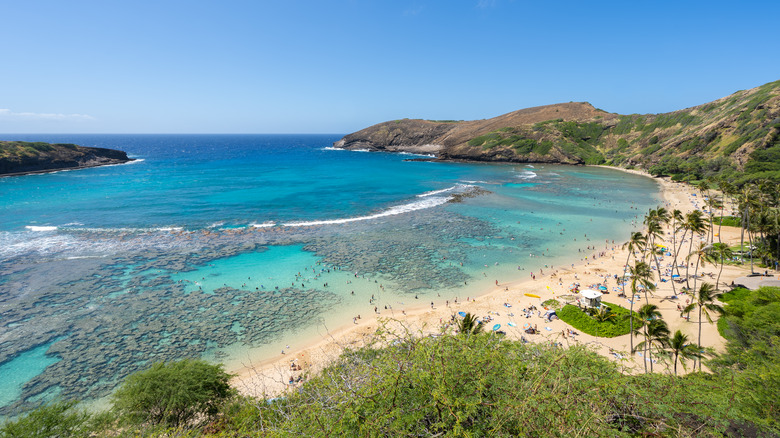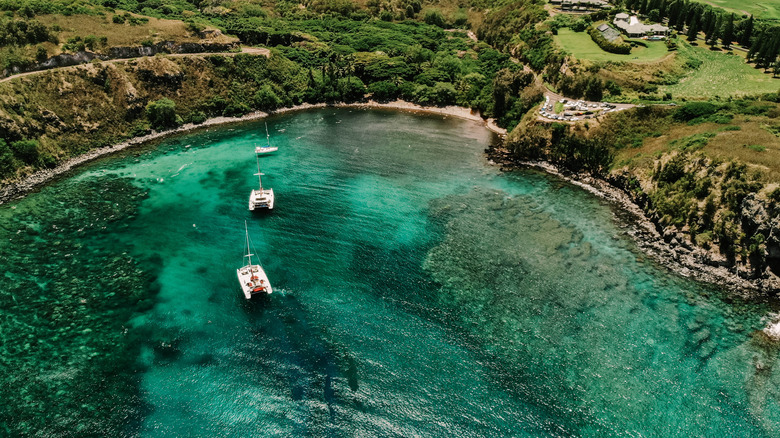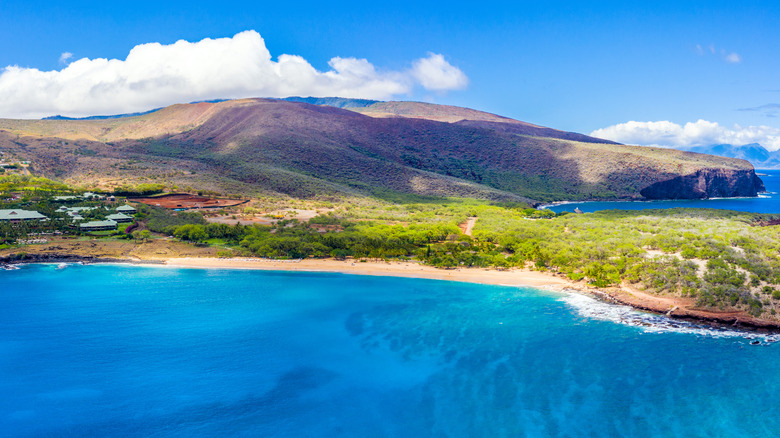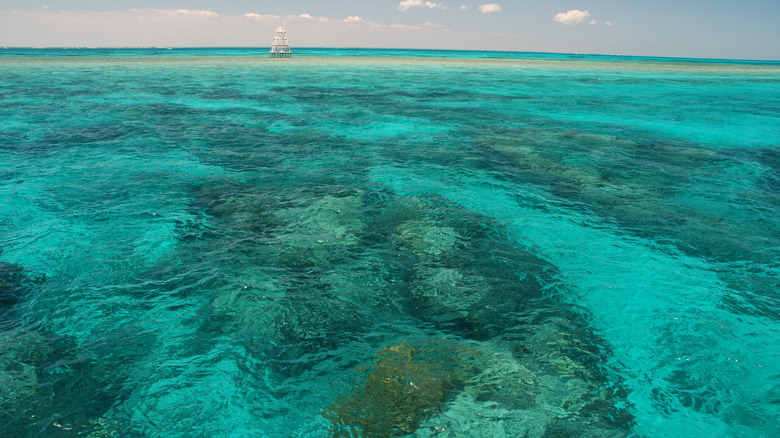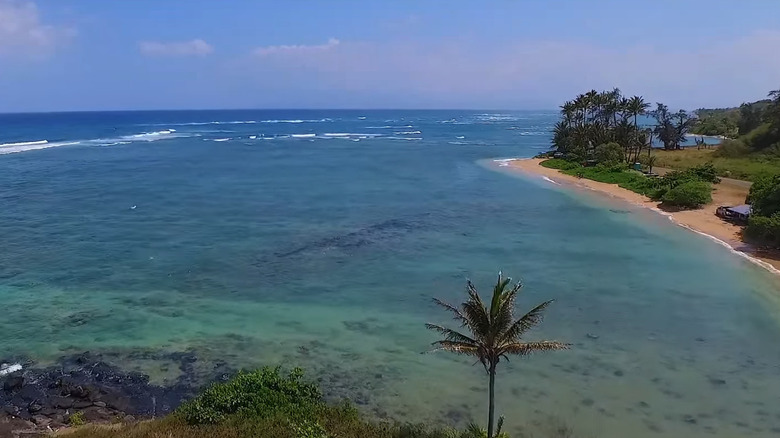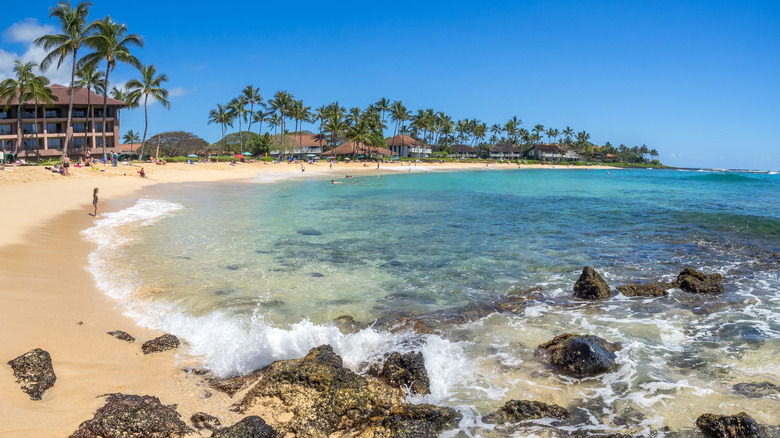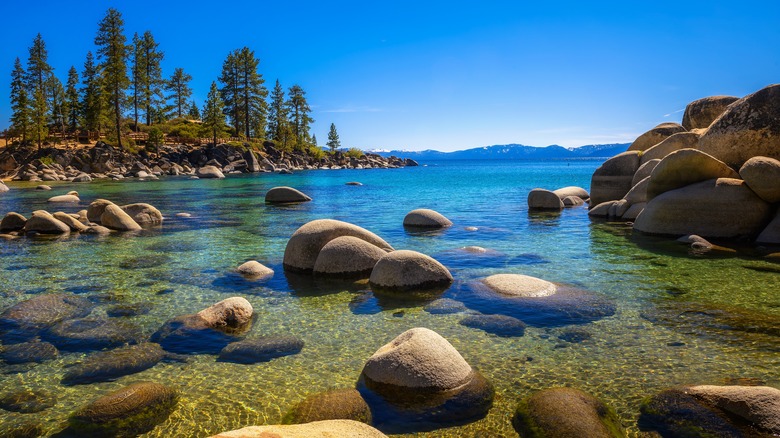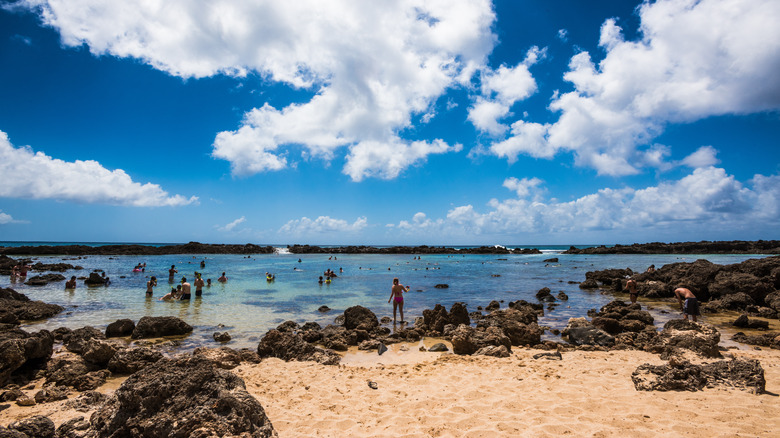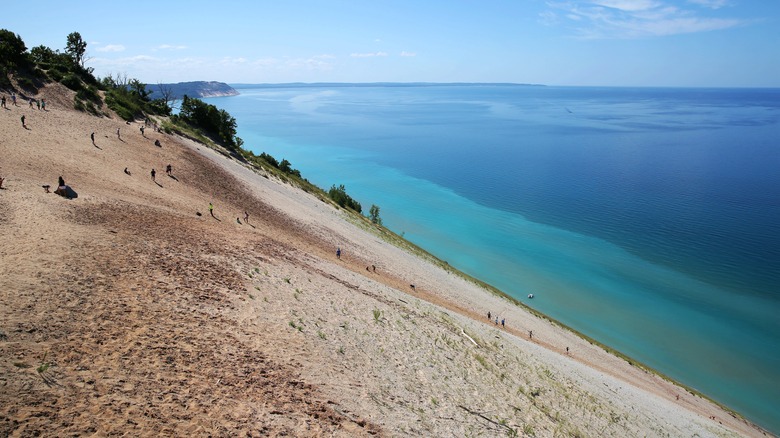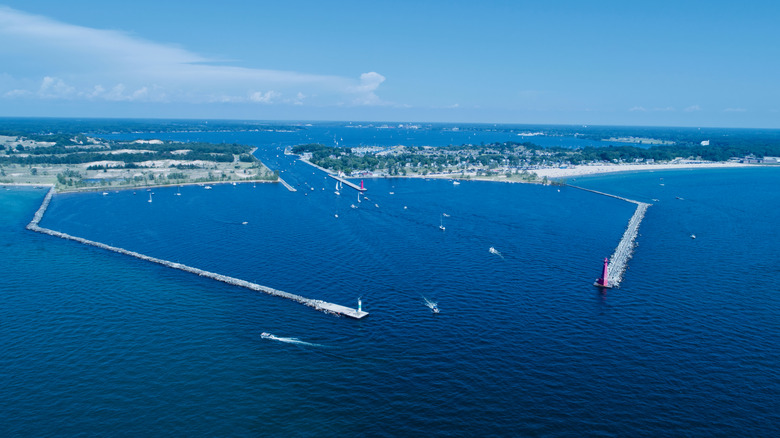Most Beautiful US Beaches For Snorkeling
Is there a more satisfying sensation during the summer than slowly warming up on the soft sand before sliding into the ocean to cool off, refresh, and prepare yourself again for another bout on the beach? Hitting the sand is a rite of passage for many travelers during the year's warmest season, and not only is it a relaxing way to spend time outdoors, it's also one that brings us fond memories. On any trip, we might not remember the choreography of a particular meal, the way we navigated to a lauded landmark, the sound of a city, or the wind on a mountain, but invariably we'll recall the time spent on the beach, the way the sand felt between our toes, how the water met the shore, its clarity and warmth, and the feeling of floating in it.
A day at a beach can be even more magical if snorkeling is an option. The United States has more than 12,000 miles of coastline — a wealth of waterfront, indeed. There is an embarrassment of riches when it comes to beaches, and many fine ones with excellent snorkeling to boot. The list below showcases some of the best, as well as other gems that aren't by a beach (but easily reached from terra firma) that are worth checking out.
Block Island
A summer haunt in Rhode Island that sits south of that state, and off the east coast of New York's Long Island, Block Island has some fabulous beaches and the charming allure of a classic New England seasonal break. There's much to pull visitors here, from lovely bike rides around semi-rural roads, to wandering around quaint hamlets with independent boutiques.
Then there are the beaches dotted all over the island, from Cow Cove in the north to Black Rock in the south. One of the finest strands of sand is Surf Beach. Given the name, it would be fair to assume Surf Beach is the island's top area for surfing, but that honor actually belongs to Black Rock. Surf Beach, however, is the place to go if you'd like to throw on a snorkel and peer under the surface. The water in the area is pretty shallow, so it's perfect for anyone who doesn't want to paddle out in deep waters while on their snorkeling adventure. In the shallows, crabs and starfish are commonplace.
Catalina Island
Set offshore between Los Angeles and San Diego, this Californian island — which is formally named Santa Catalina Island but typically known by its shortened form — offers visitors a good spread of places where they can strap on a mask and plunge into the depths. The waters of Catalina Island are clear, though said waters can be rather brisk outside of summer; a wetsuit is essential during the cooler months. Snorkelers can venture out on their own or join the many groups and tours that come here each day. Part of the waters fall under the remit of a protected marine area, so sea life is all but guaranteed to be vibrant and healthy.
Popular spots include the Lover's Cove Marine Preserve, or the part off of Descanso Beach, which is on the southeastern side of the island. Visitors are likely to encounter sea life such as halibut, sea bass, and possibly even harbor seals.
Crystal River
At this waterway north of Tampa on Florida's Gulf Coast, the draw for snorkelers is the chance to swim with manatees in their natural environment. These aquatic mammals — which look a cross between a seal and a rotund cow — are adorable creatures, remarkable for their gentle nature, and languid method for gliding through the water. At the Crystal River National Wildlife Refuge visitors can get into the crystal (no pun intended) waters and paddle near these magnificent sea animals. While tourists may be tempted to visit during a warmer time of year, you're more likely to spot more manatees during the late fall through early spring.
While the Florida manatee might no longer be endangered, their existence is very much under threat. Tours are often kept small in number, and include a journey into the refuge on a boat where other marine wildlife might come into view, and also a swim in Three Sisters Spring nearby.
Crystal Cove State Park
Located in Newport Beach, California, Crystal Cove State Park cedes to an official Marine Protected Area, a way to safeguard the aquatic flora and fauna in waters around the country. This safeguarded underwater realm, spread over 1,100 acres, has rocks and reefs where creatures congregate to feed and rest, but what really makes it stand out are the stretches of kelp forest, marine ecosystems where animals such as eels and sharks might roam.
Swimmers will need stamina to access the main snorkeling area, located between Pelican Point and Reef Point parts of the state park, and entry can be rocky at some spots, so caution is critical. In addition to the species already outlined, adventurers might spy rays and garibaldis, a bright yellow-orange species that is the state's marine fish — and is illegal to catch. Elsewhere in the marine preserve, for those that like to dive, a plane dating to World War II lies in the depths out from Reef Point.
Dry Tortugas National Park
For some of the clearest waters in the Lower 48, visitors will need to get on a boat or seaplane to reach this Dry Tortugas National Park. The trip from Key West, which has some of the best sunset views in the country, is 70 miles, but once you get here, what is evident is that the effort will be worth it. The park extends across 100 square miles, and encompasses a former naval outpost, some small islands, and, of course, picture-perfect beaches and water.
The snorkeling is sublime, with healthy reefs and so much aquatic life. There are fine places all around the park to snorkel, but a couple of experiences really stand out. The old pier pilings, put in place by the U.S. Navy in the 19th century for a pier that was later destroyed by a hurricane, are today a fertile arena for larger species, like the barracuda and some sharks. For a unique adventure, snorkel around the moat wall at night, along the western side of Fort Jefferson, where the water is shallow and night creatures like octopus and basket starfish come into view.
Garrett Bay
At the end of a peninsula on Lake Michigan, this Wisconsin slice of waterfront has dramatic coastal scenery, and a shipwreck that lies a close distance to the shore. In 1888, the schooner "Fleetwing" sank in the waters of the Great Lakes, and now sits in the shallows of Garrett Bay. The water here is very clear, and floating above the cargo ship, which has separated into a few different sections, is an exciting exercise. Some parts of the vessel rest just five feet below the water, with the main bulk of the ship a few feet deeper.
Access to the site is from the bay's stone beach, and, looking north over Lake Michigan, there is certainly a feeling that you could be peering into eternity over a calm sea. There is also great kayaking here, especially along the rocky escarpments of Door Bluff Headlands County Park, right next to the bay.
Hanauma Bay Nature Preserve
For visitors to Honolulu, this destination on the south coast of Oahu is an easy escape. Due to its proximity to Hawaii's main tourist city, the natural area was a victim of its own success, and became blighted by overuse. The city proposed a plan in 1990 to overhaul the Hanauma Bay Nature Preserve, and one of the main steps was implementing a cap on visitor numbers. The result has been a triumph, and now the waters here have regained their health.
There is still a large car park set on one side of the U-shaped bay, and once at the beach, visitors will be able to choose from a number of lagoons, channels, and bits of open water for snorkeling. The reefs of hard and soft coral are home to more than 400 types of fish, and other sightings might include turtles, dolphins, eels, and maybe even a humpback whale further out in the bay.
Honolua Bay
Part of the Hawaii Marine Life Conservation Districts, this bay in Maui sits next to Mokulē'ia Bay, separated by Kalaepiha Point that reaches far out into the water. While the area directly by the bay is a little unclear, as an inland stream empties into the open water, the water clarity gets vastly better a little further out, and along the bay's flanks, where there are lots of coral reefs. Beachcombers might like to explore the bay's caves and rock arches before heading into the depths.
Swimmers here should be confident, since getting to the reef requires a little effort. That said, the rewards are immense, with fish on display including boxfish, damselfish, grouper, parrotfish, the glinting chromis, and trumpetfish, as well as possibly turtle and barracuda. Mokulē'ia Bay also has reefs, and for a real challenge, you might want to head from one bay over to the other via the sea. Fair warning: you should expect to be thoroughly spent by the end of the day.
Hulopo'e Bay
Shaped like a curling crescent moon, this beach on Lanai, one of the lesser-visited Hawaiian islands, has excellent snorkeling. The beach sits right by a plush five-star resort, so it's a good place to expend some energy before hitting the resort for a celebratory meal or libation. The beach itself is glorious, voted the best beach in the United States in 1997 by self-proclaimed beach expert Dr. Stephen Leatherman, aka Dr. Beach. Its gorgeous, soft sand and clear waters are a sight for sore eyes, to say the least. Even if you don't snorkel, it's worth coming here just to lounge on the sand and bathe in the silky ocean.
Apart from the usual marine life that can be seen in Hawaii, travelers can explore the tide pools, hewn from volcanic lava, and filled with hermit crabs, juvenile fish, sea stars, and much more. Further out in the bay, spinner dolphins and even humpback whales have been known to shimmy by.
John Pennekamp Coral Reef State Park
In Florida's Key Largo, this marine marvel is distinguished by being the United States' first underwater sea park. The park's purview spans 70 nautical square miles (more than 90 conventional square miles), and is populated with bright coral reefs, an underwater bronze statue of Christ called the Christ of the Abyss, and plenty of marine creatures that have made this sanctuary their home.
While some come here for the opportunity to hike on marked trails or kayak on the clear waters, the real draw is the exploration while in the water, either snorkeling or diving. Most visitors might gravitate to the reefs, those dependable realms of color, life, and activity, but the park is also home to mangroves and fields of seagrass, calm areas that also offer excellent snorkeling opportunities, good options on days when the open water is a little choppy. It's in these areas that you are more likely to see a seahorse or pipefish, and certainly juvenile fish that use these ecosystems as a training ground before they find their "sea legs."
Kūmimi Beach
The island of Molokai only receives a few thousand visitors a month, so for the scores of travelers that come to Hawaii without stopping by Kūmimi Beach, you don't know what you're missing. For one thing, you will not experience this breathtaking beach with soft golden sand and tranquil turquoise seas that are among the best on the island for snorkeling. Facilities are almost non-existent, and visitors should come here with the plan to be fully self-sufficient (there aren't even restrooms).
The entryway to the water can be rocky at low tide, so snorkelers should plan to hit the sea at high tide. Once wet, expect to put on your mask and see the brilliant black-and-yellow-striped Moorish idol, the bright yellow tang, and the parrotfish, the species with perhaps the most trippy hues of all. Elsewhere on Molokai, travelers will be able to see the tallest sea cliffs in the world.
Poipu Beach Park
Another beach that is special in its own right — it was in Dr. Beach's Top 10 beaches of 2023 — Poipu Beach Park on Kauai is great for lounging in the sea, and also for snorkeling. It is a solid spot to watch turtles, wrasse, butterfly fish, and flounder going about their daily activities in the tropical Pacific shallows. This park actually comprises two sections, both with a slightly different ambience. One side is extremely calm, making it good for novice swimmers and young children, and there is a lifeguard on duty.
The other half has a little more action, and it's where to spot the stand-up paddle boarders and the snorkelers. Neighboring the park, Brennecke's Beach also promises some roiling water action to get the heart pumping, but in the winter, the swells seem to calm down, and turtles frequent the placid waters here, making it a good alternative — or accompaniment — to Poipu Beach.
Sand Harbor
Given that the peaks around Lake Tahoe are popular with skiers in the winter, the waters of the lake aren't likely to be renowned for their balmy warmth. Dipping into the lake is a bracing affair, but that shouldn't deter visitors from coming here to snorkel. After all, the water itself is crystal clear, the most important ingredient for a good snorkel excursion. At Sand Harbor, on the Nevada side of the lake, there are large boulders strewn among the waters and this creates an environment filled with interesting things to see.
Among the sightings in the water might be mountain whitefish, Tahoe sucker, and schools of trout. What makes the experience extra special, and wildly different from most other places on this list, is the sight of mountains ringing the lake, a dizzying contrast of terrain and color, as well as water that is almost transparent, such is its clarity.
Shark's Cove
Part of the Pūpūkea Marine Life Conservation District in Oahu, which stretches along a mile of the coast and encompasses about 100 acres, this waterfront area has no shortage of rocks. If you decide to wade in, you would be wise to put on water shoes first. The district is home to a number of endangered species, and there are caves and tide pools to explore here, the destination home to 80 fish species and plenty of different types of algae.
Given the rich array of tide pools and tidal conditions, Shark's Cove welcomes plenty of shorebirds, as well as seals, rays, and sharks in the water. The waves can be rough here, but when the water is calm, usually in the summer, the snorkeling is excellent, with lots of coral, and sergeant major, mullet, boxfish, and wrasse among the marine life that call this place home.
Sleeping Bear Dunes National Lakeshore
The shipwrecks in the Manitou Passage Underwater Preserve are close to the shore of North Manitou Island, just off the coast of the Sleeping Bear Dunes National Lakeshore in Michigan. Getting to the islands requires a boat trip, but once on shore, some of the wrecks can easily be reached from the island's beaches. Some parts of the steamer "Three Brothers" are only five feet below the water, and bits of it remain unbroken.
The "Francisco Morazan" is a short swim out from South Manitou Island, a freighter that hit rocks and now sits in shallow waters, much of that boat sitting above the waterline. There are many other wrecks to explore here, and for wreck divers, the area is a paradise on the Great Lakes, a reminder of the days when shipping was booming here. Back at Sleeping Bear Dunes, former dock pilings are now fertile breeding grounds for fish, offering great snorkeling there as well.
Tunnels Beach
Also known as Makua Beach, this spot on the north shore of Kauai embodies what people think of when picturing a Hawaiian beach. The shoreline of Tunnels Beach is a tree-lined paradise, and the water is a clear, inviting turquoise. As if it was not all idyllic enough, jungles and hills sweep inland to add some variation and verticality to the panorama.
Visitors come here to surf and soak up the sun, but for snorkelers, the marquee attraction is the chance to explore the underwater caverns here and swim among monk seals. The reef to the west is a true highlight, a spot where you can expect to see parrotfish and tang, as well as maybe some turtles. In the deeper areas, look out for the Hawaiian monk seals. You might even see the playful mammals make their way to the beach, too. Just remember to be mindful of their space.
West Michigan Underwater Preserve
Close to the Muskegon Channel's beaches, this part of the state has plenty of shipwrecks just offshore. Some of the sites are closer to the shoreline, whereas others require access via a boat and by using dive equipment. The West Michigan Water Preserve actually spans a much greater area than just around the channel, beginning from Grand Haven in the south and extending up north to Pentwater.
A couple of wrecks that are easy to reach from the beachfront here are the "Henry Cort", which sits a little past the Muskegon State Park North Channel Pier in 15 feet of water (the boat was constructed in the late 1800s, and sank in 1934), and a little north is the "Helen," which is in even shallower depths. Right by the channel, the sandy shores of Muskegon State Park are a delight, and a great place to grab some rest in between bouts of snorkeling.
